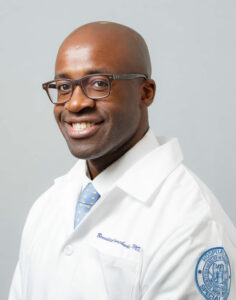Tendon Repair Surgeon

If you play sports or experience a trauma to the knee you may be at risk of developing a tendon injury. Common symptoms of both quadriceps tendon and patella tendon injuries include pain, tenderness, bruising, displaced kneecap, and inability to completely straighten the knee. Tendon repair surgeon, Doctor Benedict Nwachukwu provides diagnosis as well as surgical and nonsurgical treatment options for patients in Manhattan, New York City, NY who have sustained a tendon injury. Contact Dr. Nwachukwu’s team today!
Where are the tendons in the knee?
The knee has two important tendons which connect the muscle to the bone. These are the quadriceps tendon and the patellar tendon. The quadriceps muscle is found in the front of the thigh and is connected to the patella (kneecap) by the quadriceps tendon. The patella connects to the tibia with the patellar tendon. The patella tendon is sometimes called the patella ligament, because it connects two bones. Dr. Benedict Nwachukwu, orthopedic knee surgeon, specializes in the treatment for knee tendon injuries for patients in Manhattan, New York City and the surrounding New York boroughs. He can diagnose and treat a number of knee tendon injuries and help patients return to the work and sport that they love.
What are common knee tendon injuries?
The tendons in the knee can become injured through sports activities, trauma or from tendon weakness. Two common tendon injuries are a patella tendon tear and a quadriceps tendon tear:
- Both types of tears can be partial or complete.
- Partial tears can be compared to a rope, where the fibers are frayed, but the rope remains in one piece.
- Complete tears or a tendon rupture means the tendon is in two pieces. The Tendon is separated from the kneecap or can tear in the middle of the tendon.
What are the symptoms of a knee tendon tear or injury?
Common symptoms of both a quadriceps tendon injury and a patella tendon injury are:
- Pain
- Tenderness in the knee
- Bruising
- Cramping in the knee
- Indentation at the bottom of the patella (tendon rupture)
- Displaced kneecap
- Difficulty walking
- Patella that moves easily and is no longer anchored to the tibia
- Inability to completely straighten the knee
- Knee Instability, feeling of the knee “giving way”
What is a tendon repair?
Complete tears or ruptures of the tendon require surgical repair in order to regain knee function. Ideally, the surgery is performed shortly after the tear to prevent the tendon from withdrawing into the knee and to prevent scarring. Both a patella tendon tear and a quadriceps tendon tear can be repaired in a similar surgical procedure that reattaches the torn tendon to the kneecap.
How is a knee tendon repair performed?
During this specialized procedure, Dr. Nwachukwu will drill small holes in the patella (either at the top or the bottom). Sutures are then placed in the torn tendon and then threaded through the holes in the kneecap. (In some patients, suture anchors may be used in place of drilling holes in the kneecap).In a patella tendon repair, the sutures are tied or anchored at the top of the kneecap; in a quadriceps tendon repair the sutures are tied or anchored at the bottom of the kneecap. Dr. Nwachukwu will carefully tension the knee appropriately with the sutures and will make sure the position of the patella closely matches the uninjured knee.
What if the knee tendon cannot be repaired?
There are situations where the knee tendon has retracted into the leg or is damaged, making it difficult to reattach the tendon to the kneecap. If this occurs, Dr. Nwachukwu may add a tissue graft to lengthen the tendon, or to replace the tendon. He may use the patient’s tissue (autograft) or donated tissue (allograft).
How long is the recovery after a knee tendon repair?
Patients in the New York area who undergo a knee tendon repair can expect the following:
- Immediately following surgery the knee will be placed in a brace to protect the healing tendon and to immobilize the joint.
- Pain medication will be prescribed to be taken only as directed.
- Passive knee motion will begin to activate the quadriceps muscle and to begin range of motion.
- Patients will be weightbearing as tolerated with the knee fully locked in extension for the first 2 weeks after surgery and then progressively more freedom of knee range of motion will be allowed until the brace is discontinued at 6 weeks and patients are allowed to freely ambulate.
- Complete recovery will take about 4 to 6 months with continued improvement over the first year.
For more information about knee tendon repairs, or to have your knee pain evaluated for the best treatment options available, please contact the office of Benedict Nwachukwu, MD, orthopedic knee surgeon serving Manhattan, New York City and the surrounding New York boroughs.





